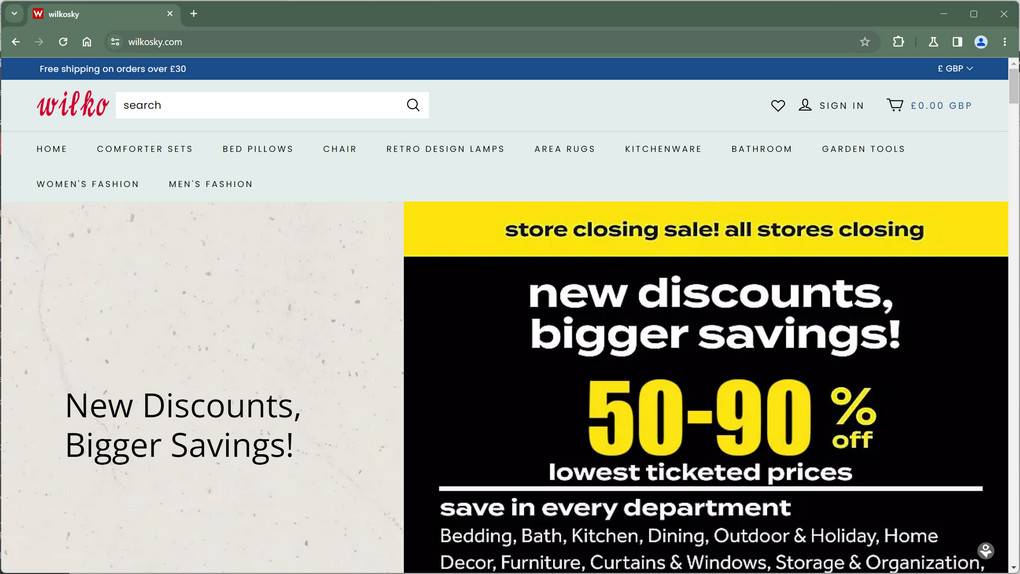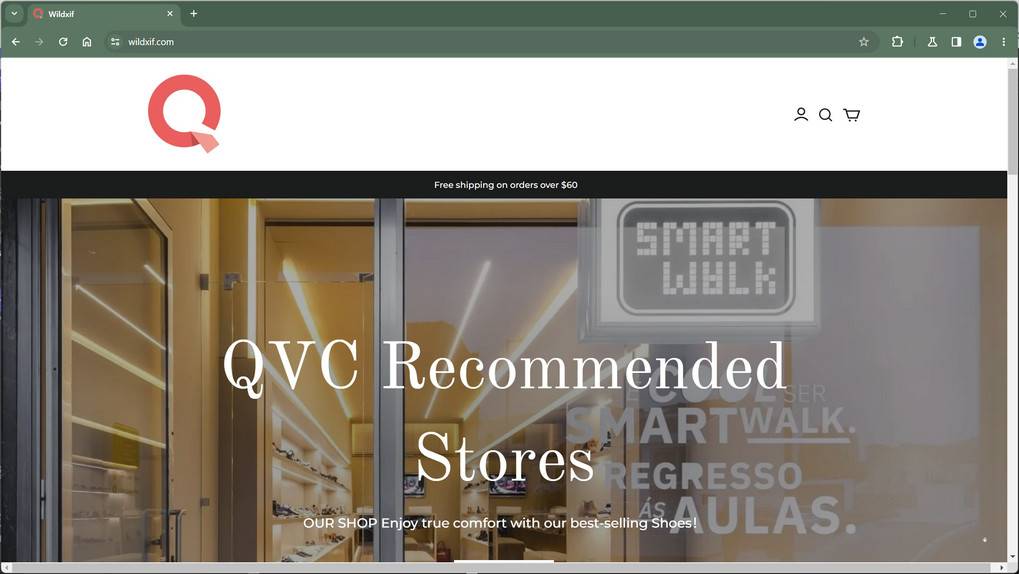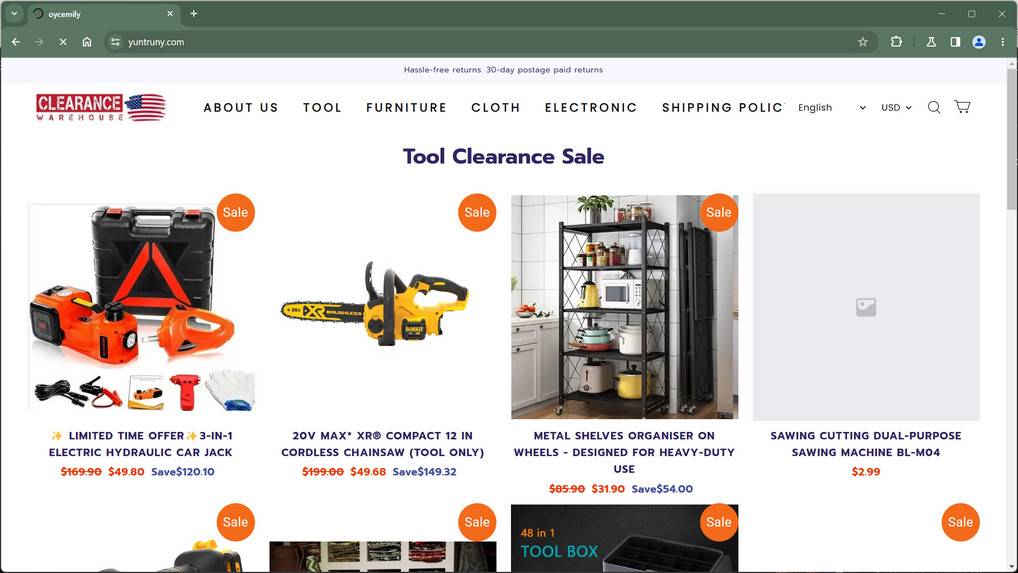You may have recently seen ads on Facebook for huge blowout sales from factory outlet stores liquidating inventory at crazy-low prices before permanently closing. These Factory Outlet Store Closing Sale scams try to lure victims in with promises of rock-bottom prices on name brand apparel, electronics, jewelry and more. But it’s just an elaborate ruse to steal money.
This guide will uncover the deceptive techniques used in this scam, how to detect their tricks, and most crucially, how to avoid getting swindled by online factory outlet store closing sale frauds exploiting social media.
This Article Contains:
Factory Outlet Store Closing Sale Scam Overview
The Factory Outlet Store Closing Sale scam employs convincing ads and fake shopping websites to scam users out of their money. Scammers create online storefronts posing as real outlet retailers liquidating wares at 75-90% off due to going out of business.
In reality, these sites are elaborate facades set up solely to defraud victims who think they’re getting once-in-a-lifetime deals on designer brands. After checkout, customers never receive any products. The “stores” vanish quickly, preventing victims from pursuing refunds.
Some common red flags exposing these closing sales as scams:
- Website domain registered very recently before the purported liquidation
- No indication of actual retail locations closing down
- Rock-bottom prices like 90% off all items
- Countdown timers pressuring fast purchases
- Only contact is via email, no working phone number
- Name brands misspelled like Nke and Rayban
- No social media presence aside from temporary ads
With no physical stores, valid contact info, or permanent web presence, these scam outlet stores essentially disappear into thin air after collecting payments. The brilliantly convincing storefront facades and ads drive an intricate fraud bilking unwitting bargain hunters.
How the Factory Outlet Store Closing Sale Scam Works
The outlet store closing sale scam starts with eye-catching social media ads announcing the impending shutdown of a major factory outlet retailer. The ads proclaim deep discounts of up to 90% off everything in stock with limited time left before permanently closing.
When users click through to the store’s website, the site sports a polished template resembling a legitimate retailer. Sections feature brand name apparel, shoes, accessories, electronics, beauty items and more at unbelievable markdowns.
No indication appears about which physical outlet locations are liquidating inventory. Buried in small print might be a vague notice that sales are online only.
The website pressures buyers to purchase immediately before stock runs out. Countdown timers create urgency alongside claims of dwindling inventory. There are no channels for direct communication – just an email for issues.
After checkout, customers receive no confirmation or shipping details. The website becomes unreachable soon after and emails go unreturned. No products ever ship out, but victims’ payment information has already been stolen.
Some users report eventually receiving cheap counterfeit items weeks later that barely resemble what was pictured. Requests for refunds are impossible as the sites vanish quickly after collecting payments during the “limited-time” sale.
A few customers may get credit card charges reversed under fraudulent transactions. But most victims have no option other than absorbing the lost funds, unable to even identify who scammed them with fake outlet store closing sales.
How to Spot The Scam Shopping Websites
While scam sites appear convincing at first glance, several red flags can help identify their fraudulent nature:
Check for a Legitimate Domain Name and Company Details
- Fake sites often have domain names with odd spellings, extra words or use popular brand names. Search the company name online to confirm they are real.
- Check that a physical business address, working customer service phone/email are provided. Lack of real contact details indicates a shady seller.
Look for Overly Good-to-Be-True Deals
- Scam websites lure customers by advertising extravagant discounts of 50-90% off or deals well below market prices. Real businesses cannot sustain such heavy losses. If the deal looks too good to be true, it likely is.
Verify Company Reputation
- Search the website, business name and owner names online for any negative reviews or scam reports. Check with BBB, TrustPilot and complaint forums to see their reputation.
- No social media presence and zero signs of real customer activity on review sites signal likely frauds.
Analyze Site Security and Payment Options
- Ensure sites connect with SSL encryption and have guaranteed refund policies. Unsecured sites should not handle payments or sensitive data.
- Scam websites tend to only take irreversible payments like wire transfers, gift cards, cryptocurrency and avoid credit cards with stronger fraud protections.
Spot grammar errors, plagiarized policies, limited products
- Fake sites lack effort invested into proper grammar and original legal policy writing seen on established businesses.
- Very limited product selections avoiding common best-selling items categories also indicates pop-up scams.
Carefully applying these warning signs allows shoppers to expose scam retail fronts seeking solely to exploit rather than serve legitimate customer bases built on accountability and trust.
How to Spot This Scam on Social Media
In tandem with operating entirely fake e-commerce storefronts, retail scam websites heavily leverage sponsored social media ads promoting unbelievable yet highly compelling deals up to 90% off across product ranges in attempts to lure target audiences.
Highly deceptive posts explicitly screaming too-good-to-be-true price cuts frequently overrun Facebook feeds, Instagram stories and TikTok streams with aims of deceiving deal-seeking shoppers. However, certain patterns across these advertisements expose their underlying deceitful intentions.
Spotting Fraudulent Facebook Ads
Beware of too-good-to-be-true deals in Facebook ads like “90% off” or “Free Shipping” that entice people to shop. Scammers know how lucrative Facebook’s 2 billion users can be. Warning signs of a scam Facebook shopping ad:
- Extreme discounts such as “Store Closing Sale” or “Going out of Business” that seem suspicious for a newly created page. Legitimate businesses usually don’t heavily discount new inventory.
- Language and grammatical errors or inconsistencies throughout the ad or website. This signals the scammers likely quickly generated the content.
- Generic stock images of products rather than real images. Or images with watermarks that the scammer likely didn’t have rights to use.
- Very recent Page creation date shown under the Page name. Scam sites don’t last long before users report them or Facebook removes them.
If an ad or Page sets off warning bells, search for reviews of the website before purchasing. Or reverse image search any product photos to see if they were stolen from another site. Don’t support scammers taking advantage of Facebook users.
Spotting Fraudulent Instagram Ads
Scam online shopping sites try luring Instagram users with attention-grabbing captions like “Limited Time Offer!” and enticing prices such as “Today Only $39”. But is the Instagram shop legit or a scam? Signs to help determine:
- The account has very few posts and followers. Scams setup disposable accounts that get deleted once reported.
- Check user tags on the posts. If real people aren’t shown wearing or using the products, that’s a major red flag.
- Tap on the shop link in the bio. If there’s no HTTPS or SSL certificate, it’s not secure to enter payment information.
- Reviews seem fake or non-existent. Scam sites don’t have much satisfied customer proof.
- Limited or vague return policy information. Or difficult channels to request a return.
Trust your instinct if an Instagram shop seems fishy. Check independent review sites first before buying through an unknown seller advertising on Instagram. Protect your personal and payment information entering it only on secure sites after verifying legitimacy.
Catching Fake TikTok Ads
Scam TikTok shopping sites try attracting traffic using compelling videos showcasing unbelievable deals. But amazing discounts and prices may bait unsuspecting TikTok users into a scam. Be wary of:
- Links in the caption or videos bringing users to store sites no one’s heard of. Scammers setup temporary sites that won’t be around long.
- No blue checkmark verification badge on the account. This signals TikTok hasn’t authenticated the authenticity of the seller.
- Prices drastically slashed with countdown timers pressuring purchase decisions. Scare tactics rush rational judgement.
- No reviews or evidence showing real customers enjoying the products. Easy with video testimonials to fake satisfaction.
Check comment sections on TikTok scam shopping site videos for warnings from others getting duped. When prices seem too good to be true, they most likely are. Verify legitimacy before handing payment info to unknown sellers promoting on TikTok videos. Your security comes first.
What to Do if You Are A Victim
If you have fallen victim to this scam, you should take immediate action to protect yourself and your money. Here are some steps that you can take:
- Contact your bank immediately – Alert your bank to disputed charges and consider canceling your card to prevent further fraudulent purchases.
- Keep records – Save receipts, emails, screenshots, and any details related to the transaction. This provides proof of the scam.
- File a complaint – Report the fraud to the FTC and Internet Crime Complaint Center. Provide any relevant records.
- Leave online reviews – Post details of the scam on consumer review sites to warn others. However, don’t defame legitimate businesses.
- Report social media accounts – If the scam involved social media, report the accounts to get them removed.
- Reverse payments – If you paid with a credit card, request a chargeback. For wire transfers, contact the recipient bank to possibly reverse it.
- Check credit reports – Request credit reports to check for any accounts opened fraudulently using your information. Consider placing a credit freeze if needed.
- Reset account passwords – Change passwords on any online accounts that used the same login credentials entered on the scam site.
- Check your device for viruses – Run a Malwarebytes Anti-Malware Free scan to check for any malware that may have infected your device through the site.
- Learn from the situation – Study how you were deceived so you can avoid other scams in the future.
Being vigilant against shopping scams and acting quickly when scammed can help limit financial and identity theft impact. Report it to help authorities investigate and shutdown scam sites that are still active.
Factory Outlet Store Closing Sale Scam FAQ
What is the factory outlet store closing sale scam?
It’s a scam where fake ads and websites pretend to offer huge discounts on a factory outlet retailer closing down. But it’s all a fraud to steal money.
How does the outlet closing sale scam work?
Scammers use convincing ads and storefront websites announcing liquidation sales due to impending closure. After purchases, customers never receive any products.
What are some red flags of this scam?
Unbelievable discounts like 90% off, fake limited timers, no physical location details, new website domains, misspelled brands, and only email contact.
What happens after I place an order?
Most likely your order will disappear with no shipping confirmation. The site will vanish quickly after the “sale” ends, preventing refunds.
Can I get my money back if I fell for this?
If you paid by credit card you may be able to dispute the charges as fraudulent. File complaints immediately with agencies like the FTC.
Why are they impersonating real factory outlets?
To make the liquidation sales more believable. Real brand names and store templates trick users into thinking the deals are legitimate.
Do these scammers ever ship actual products?
In some cases, victims report eventually receiving cheap counterfeit items weeks later that are very low quality knockoffs.
How can I identify these scams before ordering?
Look for no indication of real stores closing down or locations mentioned. Research legitimacy and watch for new site domains.
Why offer such huge discounts like 90% off?
It creates urgency to buy quickly before scrutinizing the validity. Big discounts also attract more potential victims.
How can I avoid becoming a victim in the future?
Carefully research sellers and deals that seem unrealistic. Avoid direct money transfers with unknown companies.
Conclusion
The Factory Outlet Store Closing Sale scam plays on the disappointment of missing huge liquidation discounts. But the stores are elaborate shams intended solely for stealing money through deception.
Scrutinizing unbelievable deals, website domains, and company validity is crucial before purchasing. Also be wary of pressuring limited-time sale tactics. With vigilance, social media users can evade these viral outlet closing scams exploiting those searching for the best deals.
















